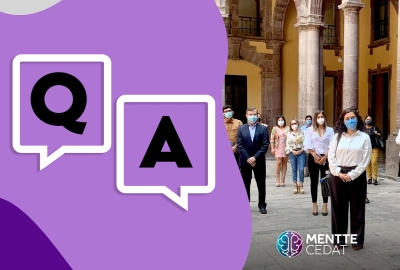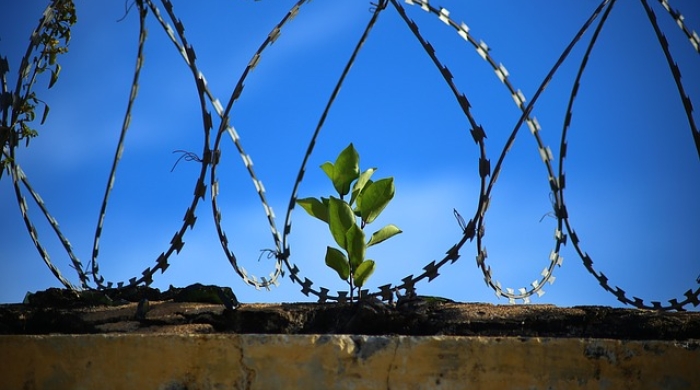
Since 2014, researchers at the Institute of Human Development and Social Change and Educational Alliance have partnered to build capacity for community-based programs that support children, caretakers, and families living in poverty. On the Ground spoke to Rubén Castañeda (Director, Mentte Cedat), Oscar Limón (Innovation and Knowledge, Mentte Cedat), and Dr. Anil Chacko, Associate Professor of Counseling Psychology at NYU Steinhardt, about their flourishing partnership.
Could you tell our readers more about Mentte Cedat? What are some of the key challenges that you aim to address, and what have some of your successes or findings been to date?
Ruben Castañeda: We are a nonprofit organization based in Mexico. Nowadays, we are working basically with the juvenile justice system and partnering with government agencies that enforce the law, mostly on the side of taking care of the young people who committed crimes such as homicide or robbery. One of our successes is to have a mindfulness and cognitive behavioral therapy protocol to address these young people. In the Mexican context, we have a lot of people committing crimes. In our state, we are talking about 70,000 young people committing some crime every year. In order to address this large population, we would need new and cheaper strategies, so we are trying to develop high impact, low budget science-based interventions.
We face two key challenges. First, we are talking about a misrepresented population or an excluded population. The young people who have committed crime in Mexico, it's not a population that traditionally people want to take care of or that government public policy wants to take care of. It’s difficult to raise awareness with stakeholders and those who influence public policy.
On the other hand, we have a scarcity of resources. Just in Guadalajara, there are 35,000 young people who have an arrest warrant for breach of a sanction measure. We have a large population with very little funds. We’re also competing with other interventions. How can we decide which intervention is better? I believe that the decision will be centered on who has more scientific evidence of the impact.
Oscar Limón: I think one of the main obstacles is the general condition of the Mexican justice system. There are many barriers that prevent access to justice and adequate support for these young people that have committed a crime. They don't do the follow up that is necessary in order to guarantee that these persons, once they are out of the justice system, are not committing any crime. It’s really hard to get in touch with them and invite them to the program.
Another complex thing is that this type of problem has a lot of pieces around it, and we need to have a network of interventions in order to articulate all these different services and help these young people access these types of interventions more quickly. Sometimes it's hard because every institution has their own agenda. Articulating and doing these types of alliances is a little bit complicated in any context, but in particular in Mexico, it's been difficult.
Mentte Cedat works to reduce and prevent violence at both the individual and societal level. Can you tell us more about how both sides of this work come together? What makes your methods unique, and what are the benefits to considering both individual and structural components?
Castañeda: From our perspective as an organization, the violence is a systemic problem. And so we need to address which are the critical points where we can intervene and make some differences. This systemic approach is to first understand why these young people are starting to commit crimes, understanding that they are going to have, in most of the cases, a long criminal process or trajectory. On the other hand, trying to understand what are the processes which actually made them be as they are, committing these crimes. We don’t have enough evidence about the processes that lead young people to commit crimes, but there's a lot of ideas around public policy that are invested in with no evidence. For example, one idea is that young people are violent because they are poor, but we have 60 million poor people in Mexico. Why don't we have more violence or violent young people? Another idea is that “They say young people are violent because they don't have anything to do - therefore we should bring them sports and artistic activities.” There are a lot of goodwill interventions, but with no evidence at all.
Limón: We know that this is a complex problem with a lot of variables around it, and that's why we have these alliances with different experts and researchers, including Anil Chacko and other local researchers here. We're trying to measure these different variables and see which ones have a larger impact on this population. I think one of the main contributions of this organization is that at least it is interested and willing to understand deeply and with evidence how interventions can have a better impact.
Anil Chacko: I think an overarching mission is to try and develop connections among these varied siloed systems that all touch upon the lives of these individuals, the young adults, that don't currently communicate with each other. There's the intervention piece, which is at the individual level primarily, but then there's an overarching or a foundational piece that is really around using this as an opportunity to connect with other systems and have some dialogue and then move this ship in a different direction. While the intervention piece is certainly exciting, I think long-term people getting on the same page and doing some things in a systematic interconnected way will make the biggest difference for the big picture.
Castañeda: One of the good practices of this work is to understand these systems, and I think we should measure it with a more educated approach. But for example, in Mexico, there's a tradition to think that if we change the law, the reality is going to change. For example, let's make a specific law for juvenile justice, and after that, the people who are on the frontline, the field responders, don't have a clue of what to do with that.
We are training first responders in three Mexican cities. They make a lot of difference, even if they don't have enough resources. They can make a difference for the young people they attend. Sometimes these people, who are social workers or psychologists from a small city, are overwhelmed, but they are very important for our project.
Partnership plays an important role in the work of Mentte Cedat. What do partnerships typically look like? What are some of the challenges and benefits?
Castañeda: Slowly and in a very organic way, we are trying to develop something in the mind frame of a social lab. We are trying to think about solutions, thinking about it as a community, as a system, and trying to make and improve interventions. Even when we love the evidence-based public policy, we are only a nonprofit organization. We cannot have the amount of knowledge of NYU or the amount of expertise of Anil or the decision making power of the state government. So we need to work together. I think that’s the bottom line solution: in order to combat violence, we need to develop these compassionate communities to work with young people.
Limón: I think for us, generating alliances is the way to address social problems. We have a connection with different organizations and with researchers and with different actors in the system. I think we can play the role of obtaining information from different perspectives and using this knowledge in order to have a better intervention based on evidence. So for us, I think it's the key area of forging partnerships and alliances with different actors and with different backgrounds. That way we can obtain the knowledge in order to have better interventions.
How did the connection between Mentte Cedat and Anil Chacko initially happen, and in what ways have you been collaborating so far?
Castañeda: There's a not-so-obvious relationship when we talk about systems, such as how the donor can be informed of what is good to be invested in. In this case USAID is funding our program, and USAID in Mexico can do these programs, the work with juvenile justice, but actually there is not enough evidence to know which intervention is better. Even before USAID in Mexico, the government of Mexico was trying to invest in the best way they can. We collaborate in order to prove that the intervention has some evidence.
Even if it's not a very successful intervention, at least we can say, “Hey, this is not the best intervention in the world, but it's the only one in Mexico that actually has some serious evidence-based reports” and try to raise the bar of what would have to be done in Mexico for juvenile justice.
Limón: It's been a pleasure working with Anil, not just because of the expertise that he obviously has, but because we have also learned new ways of working. As we mentioned before, we have a collaboration with local researchers, and seeing all these systems and having these ways of working that Anil has provided us helps develop a different kind of relationship with our local researchers.
Chacko: Ruben, Maria, and Oscar had approached me around evaluating a specific intervention approach. I think the great thing about working with Ruben, Oscar, and all of their colleagues is that they have all this local expertise around what it means to work with this population in Mexico, and they have the background experience with this intervention. My involvement is trying to ensure that their goal of having the best evidence for this intervention is likely, given the way we designed the study and the way we measure things, et cetera. It's truly a partnership between practice and research which is great.
It's on the ground community-based service delivery with a rigorous design. We went from an open trial of a thousand young adults on probation (which is the US term) to a three arm RCT through our work together. So now we're able to better understand whether the intervention is going to have some impact, and take a dismantled approach to see if there's an added benefit of certain components of the intervention. It's all being done across Mexico, which is super exciting. Everything from design and assessment process and outcomes, fidelity, etc. are the sort of things that we have been talking about and collaborating with. I've learned so much about just the population and the work that they do and the unique challenges in Mexico in terms of lack of services or lack of evidence-based services for this population.
Over the past year, we have experienced both the COVID-19 pandemic and massive social movements focused on issues of racial justice and the criminal justice system. How have these events impacted your work?
Castañeda: In Mexico, the pandemic has caused the people to stay at home, more or less. We have seen that the violence is moving to family violence, for example. Also, since governmental institutions closed, people have not been pressing charges around the regular crimes in the city. We started dealing with the government saying “we have been so effective that we don't have that many homicides or robberies” just because no one was pressing charges.
The pandemic situation and the social movements are leading us to notice that the violence is getting worse, but it's getting more invisible. So we need to change the strategy to address the young population, because we are not going to find it near traditional places. We actually need to find them. Now we are dealing with social networks as a way to get in touch with young people in conflict with the law, which sounds very strange, but it's easier to contact them through Facebook than through the justice system in Mexico.
Limón: We have a problem here also about the way the police work and all of the discrimination that this young population experiences. During our research, we asked one of the young participants if he had been in contact with the police recently. He said, “What do you mean by contact? Because I live in this poor community and the police always go there. It's just a normal routine to be submitted to these types of actions.” We realized then that sometimes we normalize that and think that's okay. There's a lot of discrimination and a lot of things that we need to work on.
That's why we also work with the police. We have a protocol that is being transferred to these types of institutions. I think with all of these situations, what we have found out is that we need to be committed to these causes and to be designing interventions that point to these specific topics about discrimination, about the way the justice system works, the way the police are working.
Besides that, we have these conditions around the pandemic that are excluding these populations that were already vulnerable. We need to find new ways of helping these populations access these different services, including online education. But at the same time, we know that they don't have the equipment or the skills to manage all this technology. We have that challenge and, at the same time, it's an opportunity for us to design better interventions.
Related Information
Justice and Welfare Systems
Institute researchers make evidence-based recommendations for policies and programs that can reduce inequality and improve outcomes for individuals, families, and communities.
Child Mental Health Disparities Working Group
The Child Mental Health Disparities Working Group involves faculty across various disciplines partnering with key community settings to develop and evaluate novel approaches to addressing mental health disparities.
A Trauma-Informed Approach to Juvenile Justice
Dr. Carly Baetz is Assistant Professor in the Department of Child and Adolescent Psychiatry at NYU Langone School of Medicine. Her work examines the impact of trauma on justice-involved youth and the effectiveness of implementing trauma-informed services for youth, families, and staff in juvenile justice settings.




